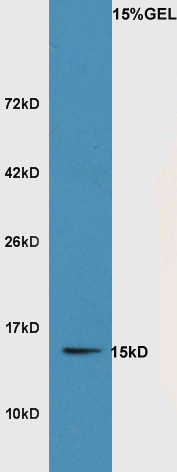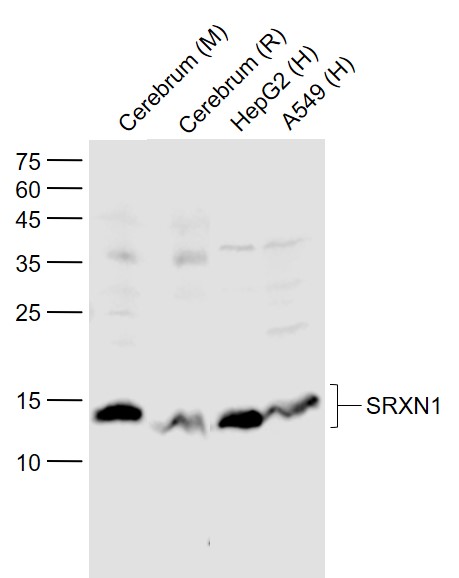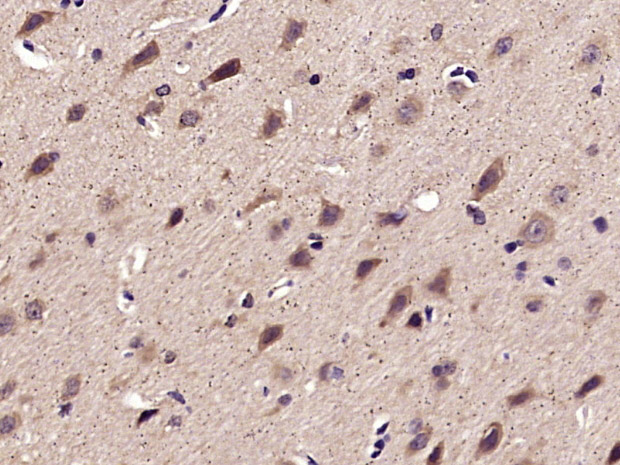
Rabbit Anti-SRXN1 antibody
C20orf1392; Chromosome 20 open reading frame 139; dJ850E9.2; Npn3; Npn31; SRX1; SRXN 1; Sulfiredoxin 1; Sulfiredoxin 1 homolog (S. cerevisiae); Sulfiredoxin 1 homolog; YKL086W; SRXN1_HUMAN.
View History [Clear]
Details
Product Name SRXN1 Chinese Name 抗氧化蛋白1抗体 Alias C20orf1392; Chromosome 20 open reading frame 139; dJ850E9.2; Npn3; Npn31; SRX1; SRXN 1; Sulfiredoxin 1; Sulfiredoxin 1 homolog (S. cerevisiae); Sulfiredoxin 1 homolog; YKL086W; SRXN1_HUMAN. literatures Research Area Cell biology immunology Immunogen Species Rabbit Clonality Polyclonal React Species Human, Mouse, Rat, (predicted: Chicken, Dog, Pig, Cow, Horse, Rabbit, ) Applications WB=1:500-2000 ELISA=1:5000-10000 IHC-P=1:100-500 IHC-F=1:100-500 IF=1:50-200 (Paraffin sections need antigen repair)
not yet tested in other applications.
optimal dilutions/concentrations should be determined by the end user.Theoretical molecular weight 15kDa Cellular localization cytoplasmic Form Liquid Concentration 1mg/ml immunogen KLH conjugated synthetic peptide derived from human SRXN1: 45-137/137 Lsotype IgG Purification affinity purified by Protein A Buffer Solution 0.01M TBS(pH7.4) with 1% BSA, 0.03% Proclin300 and 50% Glycerol. Storage Shipped at 4℃. Store at -20 °C for one year. Avoid repeated freeze/thaw cycles. Attention This product as supplied is intended for research use only, not for use in human, therapeutic or diagnostic applications. PubMed PubMed Product Detail Sulfiredoxin, also designated Sulfiredoxin-1 and chromosome 20 open reading frame 139 (C20orf139), is a cytoplasmic antioxidant protein involved in signaling through catalytic reduction of oxidative modifications. It regulates peroxiredoxins (PRXs), a family of proteins that reduce hydroperoxides, by reducing the conserved cysteine from sulfinic to sulfenic acid. This impacts the role of PRX in the reduction of other downstream transcription factors and kinase signaling pathways. The Sulfiredoxin protein specifically acts on the PRDX1, PRDX2, PRDX3 and PRDX4 peroxiredoxins, but not on PRDX5 or PRDX6. Sulfiredoxin acts as a phosphotransferase and an athioltransferase and is widely expressed, with highest levels detected in lung, spleen, kidney and thymus tissues.
Function:
SRXN1 contributes to oxidative stress resistance by reducing cysteine-sulfinic acid formed under exposure to oxidants in the peroxiredoxins PRDX1, PRDX2, PRDX3 and PRDX4. It does not act on PRDX5 or PRDX6. SRXN1 may catalyze the reduction in a multi-step process by acting both as a specific phosphotransferase and a thioltransferase.
Subcellular Location:
Cytoplasmic
Tissue Specificity:
Widely expressed with highest levels in kidney, lung, spleen and thymus.
Similarity:
Belongs to the sulfiredoxin family.
SWISS:
Q9BYN0
Gene ID:
140809
Database links:Entrez Gene: 140809 Human
Entrez Gene: 76650 Mouse
SwissProt: Q9BYN0 Human
SwissProt: Q9D975 Mouse
Product Picture
Primary: Anti-SRXN1 (SL8329R) at 1/300 dilution
Secondary: HRP conjugated Goat-Anti-rabbit IgG (SL0295G-HRP) at 1/5000 dilution
Predicted band size: 15 kD
Observed band size: 15 kD
Sample:
Lane 1: Cerebrum (Mouse) Lysate at 40 ug
Lane 2: Cerebrum (Rat) Lysate at 40 ug
Lane 3: HepG2 (Human) Cell Lysate at 30 ug
Lane 4: A549 (Human) Cell Lysate at 30 ug
Primary: Anti-SRXN1 (SL8329R) at 1/1000 dilution
Secondary: IRDye800CW Goat Anti-Rabbit IgG at 1/20000 dilution
Predicted band size: 15 kD
Observed band size: 15 kD
Paraformaldehyde-fixed, paraffin embedded (rat brain tissue); Antigen retrieval by microwave in sodium citratebuffer (pH6.0) ; Block endogenous peroxidase by 3% hydrogen peroxide for 30 minutes; Blocking buffer (3%BSA) at RTfor 30min; Antibody incubation with (SRXN1) Polyclonal/MonoclonalAntibody, Unconjugated (SL8329R) at 1:400 overnight at 4℃,followed by conjugation to the secondary antibody (labeled with HRP)and DAB staining.
References (0)
No References
Bought notes(bought amounts latest0)
No one bought this product
User Comment(Total0User Comment Num)
- No comment





 +86 571 56623320
+86 571 56623320
 +86 18668110335
+86 18668110335

